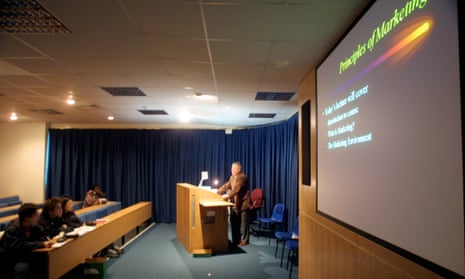I still remember the best lecture I ever attended. It was part of a joint series offered by the English and philosophy departments in my first term at university and, given that the subject was Sartre’s Being and Nothingness, should have been the dullest event in Christendom that night. But it wasn’t. The lecturer, Thomas Baldwin, had a deceptively simple style: he would write a proposition on the blackboard facing us and gaze at it for a moment, like a medium beckoning a spirit. Then he would turn and smile, and start to explain.
Baldwin paced the room – but slowly. On occasion he would stop altogether, appearing lost, a moment in which all the world’s logic seemed at stake, before somehow refinding his path to a second thrilling proposition. At one point he stood with his forehead in his hand for so long we almost called for a medic. He was so engaged, so present, that you could almost feel the motion of his mind – and through his, your own. I doubt if fewer words have ever been spoken in the course of an hour-long disquisition, and yet we all tripped to the bar buzzing with excitement afterwards. To this day, if I’m feeling blue I think back to Baldwin’s explication of the logical transition from anguish to nausea, and invariably I feel better.
Baldwin’s talk came to mind recently when I listened to a debate, on Radio 4’s Today show, about lecturing standards at British universities. I have two children at uni who have both have found lectures frustrating, so the contention of the education minister Jo Johnson that quality in this area was “highly variable” came as no surprise to me. What’s more, during sample orations on open days, I had the same experience of being bored to tears by things I felt I should have enjoyed. So when my daughter reported an exception to this rule, I knew what my first question would be.
“Did the lecturer use PowerPoint?”
“Hm. No, he just spoke,” she said.
PowerPoint is so ubiquitous that Lotte hadn’t made the connection. But the lectures I attended had left me in no doubt that Microsoft’s wildly successful “presentation” program is not just inimical to, but destructive of, deep thought, and could have been scientifically designed to put the most eager mind to sleep. The more I inquired into why this might be, the more I began to see its somnolent reflection everywhere.
Let’s stay with teaching a moment. PP’s enthusiasts claim that it emboldens nervous speakers and forces everyone to present information in an ordered way. To an extent, both contentions are true. But the price of this is that the speaker dominates the audience absolutely. Where the space around and between points on a blackboard is alive with possibility, the equivalent space on a PP screen is dead. Bullet points enforce a rigidly hierarchical authority, which has not necessarily been earned. One either accepts them in toto, or not at all. And by the time any faulty logic is identified, the screen has been replaced by a new one as the speaker breezes on, safe in the knowledge that yet another waits in the wings. With everyone focused on screens, no one – least of all the speaker – is internalising the argument in a way that tests its strength.
So, a few bored students: how serious is this? If the problem ended there, the answer would be, not very. But it doesn’t – and a glance at PowerPoint’s origins helps to explain why.
The genesis story runs like this: from the late 1950s corporations began to realise that, rather than going to the trouble of developing new products they hoped would meet a need, they could use marketeers to create the perception of need, then develop products to meet it (a shift brilliantly dramatised in the TV series Mad Men). To do this, different departments had to be able to speak to each other, to sell ideas internally. So while there had always been meetings, now there were meetings about meetings and – hey presto! – the modern world was born.
The presentational precursor to PowerPoint was the overhead projector, which is why PP screens are still called “slides”. The program owes most to Whitfield Diffie, one of the time lords of online cryptography, but it was quickly snapped up by Microsoft. Its coding/marketing roots are intrinsic to its cognitive style, being relentlessly linear and encouraging short, affirmative, jargonesque assertions: arguments that are resolved, untroubled by shades of grey.
Do we notice that, as the Harvard Business Review has observed, “bullets leave critical relationships unspecified”? No, because thanks to the relatively low resolution of most projectors, fonts must be large, words few, and thus slides many. In the face of such a procession, we switch off, because nothing is being asked of us. As the academic visual-presentation expert and PP sceptic Edward Tufte notes: “PP actively facilitates the making of lightweight presentations.” Through PowerPoint, everything has a tendency to resemble a pitch rather than a discussion: information is “storyboarded”, as for a movie – but the presentation is not a movie and the presenter is rarely Brad Pitt. No wonder we are bored.
And bored is the least of it. It’s no coincidence that the two most famous PowerPoint presentations are: a) the one presented to Nasa managers by engineers, explaining with unarguable illogic why damaged tiles on the space shuttle Columbia were probably nothing to fret about; and b) General Colin Powell’s equally fuzzy pitch for war with Iraq. Now, blaming PowerPoint for Iraq would be a bit like blaming Darwin for Donald Trump, but the program made scrutiny of the case harder. Not for nothing did Brigadier General McMaster, of the US military, subsequently liken the proliferation of PP presentation in the military to an “internal threat”, saying: “It’s dangerous because it can create the illusion of understanding and the illusion of control. Some problems are not bullet-izable.”
Perhaps even worse, in the context of the 21st century, is a charge levelled by the French writer Franck Frommer in his book How PowerPoint Makes You Stupid. Because PP can only present propositions and arguments as equations, he says, they appear to have no owner; no one need feel responsible for them. In the post-banking-crisis world, we know both how seductive this is – and how dangerous. Some canny business leaders are now following Steve Jobs’s example, and Tufte’s advice, by restricting PP use to pictures.
I spoke to a former colleague, now a professor of journalism: a super-smart, tech-savvy man who has thought about this a great deal. He reminds staff that lecturing is a form of performance and must be treated as such. He thinks the new pressure on universities to generate revenue – to behave like businesses – has tipped the balance from communicators to researchers. (Though in truth, what doesn’t take the form of a pitch in the financialised world of 2015?)
My friend also told me that when he removed PowerPoint from lecture theatres, his students demanded it back, because without it they had to organise their own notes. In this century, it seems to me, our greatest enemy will not be drones or Isis or perhaps even climate change: it will be convenience.

